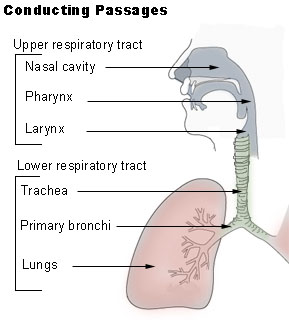User:Jmagee/HeartDissection
From WikiEducator
Following is the lab protocol for Bioscience 1 Heart Dissection. Credit to Ruth Lawson and Veronique Olin for providing the original protocol document for my modification.
Contents
Bioscience for Health 1
Name: ____________
Sheep’s Heart and Lung Dissection
Trachea and lungs

image from wikipedia
Note the structure of the Trachea (windpipe) with its rings of cartilage. Find the bronchi and bronchioles. Examine the lungs observe their shape, colour and consistency.
Heart
Before you even pick up your scalpel or scissors examine the outside of the heart and locate the following:
- The right and left atria. Note that these are dark pink flaps on the top of the ventricles of the heart. (Much smaller than shown on diagrams as they are not filled with blood).
- The right and left ventricles.
- The inferior vena cava. This passes up from the abdominal cavity through the diaphragm, to enter the right atrium of the heart. A good way to identify it is to first find the diaphragm and then follow the vena cava from it to the heart. You will find that it passes through the pericardial membrane that is probably covered with a thick layer of fat. Note: the vena cava carries deoxygenated blood and is very thin walled.
- The superior vena cava that joins the caudal one near the heart.
- The pulmonary artery (thick white wall) carrying deoxygenated blood from the heart to the lungs.
- The aorta (thick white wall). That is the largest artery carrying blood from the left ventricle to the body.
- The coronary artery and veins that carry blood to the heart muscle are situated in the grooves between the atria and ventricles.
Now cut open the heart and locate:
- The right and left atria.
- The right and left ventricles. (Note the wall of the left ventricle is far thicker than that of the right one).
- Right and left atrio-ventricular valves between the atria and ventricles. Note the “strings” anchoring the thin membrane of the valve to the wall of the ventricle. These give these valves the name parachute valves. Also note how thin the membrane of the valve itself is.
- Aorta from the left ventricle supplying the body with oxygenated blood.
- Aortic valve at the entrance to the aorta. This consists of flaps of membrane on the inner wall of the aorta. Often called a semi lunar (or half-moon) valve.
- Entrance to the coronary artery. If you look at the wall of the aorta just past the aortic valve you may be able to see the entrance to the coronary artery that supplies oxygenated blood to the heart muscle.
- Pulmonary valve at the entrance to the pulmonary artery.
- Right and left pulmonary veins leading into the left atrium from the lungs.
Now answer these questions.
- What is the name of the muscle that separates the thoracic from the abdominal cavities?
- How did you tell the right and left sides of the heart before you cut it open?
- What was the most obvious difference between an artery like the aorta and a vein like the vena cava?
- Vessels carry blood towards the heart. These are:
- One of these vessels carries oxygenated blood.This is:
- Two arteries carry blood away from the heart. These are:
- One artery carries deoxygenated blood. This is:
- What is the function of the valves in the heart?